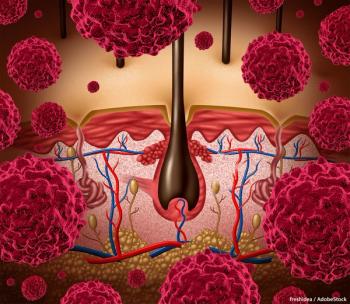
AQUILA Shows “Striking” Benefits With Daratumumab in Smoldering Myeloma
A substantial portion of patients who received daratumumab in the AQUILA study were able to delay disease progression to active multiple myeloma.
Ahead of the
Based on data from the AQUILA trial, daratumumab delayed the progression to active multiple myeloma in a larger proportion of patients vs active monitoring. Additionally, a “striking” overall survival (OS) improvement occurred in patients who received daratumumab compared with those who underwent active monitoring. According to Mikhael, the risk of adverse effects (AEs) was not particularly high with daratumumab, and patients tolerated the agent well.
Mikhael is the chief medical officer at the International Myeloma Foundation and a professor in the Applied Cancer Research and Drug Discovery Division at the Translational Genomics Research Institute, an affiliate of City of Hope Cancer Center.
Transcript:
The AQUILA trial was a brilliantly designed and carried out study in high-risk smoldering myeloma. There had been criticisms in the past of prior trials addressing smoldering myeloma, and this one sought to address each of those prior concerns. There was a defined group of individuals with high-risk smoldering myeloma. Those in both arms of the treatment were very carefully monitored with modern day imaging and careful follow up, which had been criticisms of prior studies.
The key [end point] of the trial was to evaluate the difference in progression rates to active multiple myeloma. At the 2-year mark, [for] those patients who had received monotherapy with daratumumab, 80% of them had still not progressed, whereas it was only 63% in the control arm that had not progressed. At the 5-year mark, 63% of patients in the treatment arm still had not progressed, whereas only 41% of patients in the control arm had not progressed. That was quite striking to see that difference in the percentage of patients who had progressed. Furthermore, this meant that there was a median time to progression of 41 months in the observation arm and not yet reached in the intervention arm.
But perhaps even more striking than that, this did carry over into an OS benefit. The 5-year OS was higher: 93% in those patients that had received daratumumab vs 87% in those who did not. That absolute difference may not be very large, but it was statistically significant.
What I take from that is that we can delay the progression to active myeloma in a larger proportion of patients when we treat them with daratumumab monotherapy. Thankfully, this is an agent that most patients tolerate quite well; the risk of [AEs] was not particularly high. There was not an increase, for example, in the intervention arm vs the control arm. It allowed a substantial portion of patients to delay their active myeloma and potentially never have active myeloma.
Myeloma is a disease where the average age of diagnosis is approximately late 60s [and] a bit younger in those of African descent or [who are] Latino. But for many of these patients, their diagnosis is later enough that perhaps they will never need treatment for multiple myeloma. That’s the impetus for us recognizing that this is a valid treatment strategy in high-risk smoldering [multiple myeloma].
References
- FDA approves daratumumab and hyaluronidase-fihj for high-risk smoldering multiple myeloma. News release. FDA. November 6, 2025. Accessed November 6, 2025. https://tinyurl.com/49ks5zkx
- Dimopoulos MA, Voorhees PM, Schjesvold F, et al. Phase 3 Randomized study of daratumumab monotherapy versus active monitoring in patients with high-risk smoldering multiple myeloma: primary results of the Aquila study. Blood. 2024;144(supplement 1):773. doi:10.1182/blood-2024-201057
Newsletter
Stay up to date on recent advances in the multidisciplinary approach to cancer.


















































































